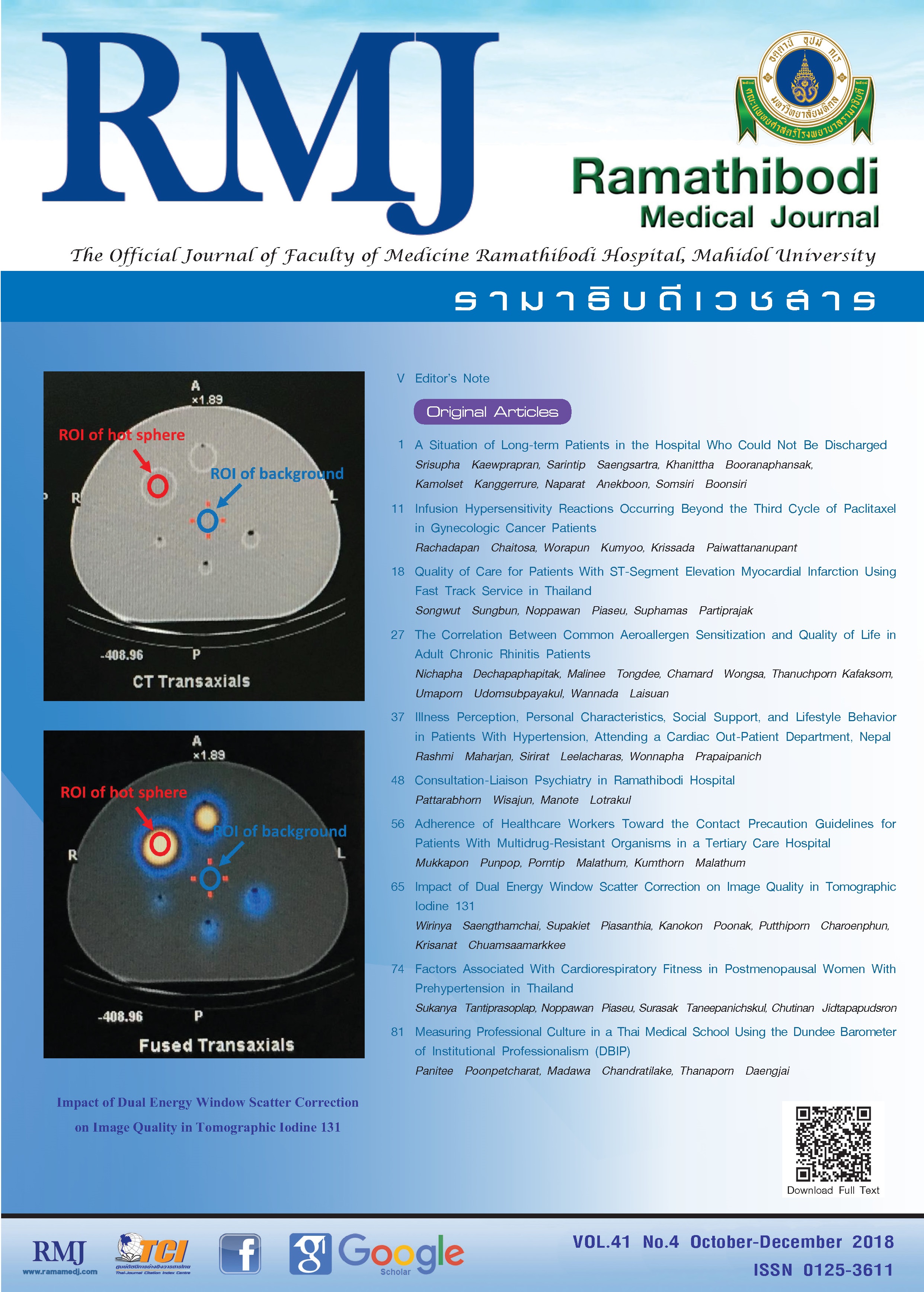Adherence of Healthcare Workers Toward the Contact Precaution Guidelines for Patients With Multidrug-Resistant Organisms in a Tertiary Care Hospital
DOI:
https://doi.org/10.14456/rmj.2018.43Keywords:
Contact precaution guidelines, Adherence to guidelines, Multidrug-resistant organisms, Healthcare workersAbstract
Background: The medical intermediate care unit (MIU) is an open ward had the highest prevalence of multidrug-resistant organisms (MDROs) in Ramathibodi Hospital. Until now, contact precautions have been used to control the MDROs in this unit.
Objective: To explore adherence of healthcare workers (HCWs) and their opinions toward the contact precaution guidelines of the hospital.
Methods: The random and blinded non-participatory observation for adherence to the contact precaution guidelines was performed. Questionnaires were used to explore opinions of HCWs to the contact precaution guidelines. Descriptive statistics were used to analyze the data.
Results: From the observation of 560 opportunities, the adherence rate to gloving was highest, followed by gowning, and hand hygiene (81%, 56%, and 51%, respectively). Forty percent of HCWs performed all steps following the contact precaution guidelines, whereas 14% did not adhere at all. Although the HCWs perceived that prevention of MDROs outbreak is important, they reported the main reasons for non-adherence toward the guidelines as having crowded environment and over workload.
Conclusions: The adherence rate of healthcare workers toward the contact precaution guidelines for patients with MDROs did not achieve the optimal goal. Thus, strategies should be planned to encourage HCWs to adhere to the contact precaution guidelines and to minimize the barriers as much as possible to prevent widespread MDROs and to improve patient care quality.
References
2. Boucher HW, Talbot GH, Bradley JS, et al. Bad bugs, no drugs: no ESKAPE! An update from the Infectious Diseases Society of America. Clin Infect Dis. 2009;48(1):1-12. doi:10.1086/595011.
3. Larson EL, Quiros D, Giblin T, Lin S. Relationship of antimicrobial control policies and hospital and infection control characteristics to antimicrobial resistance rates. Am J Crit Care. 2007;16(2):110-120.
4. Young LS, Sabel AL, Price CS. Epidemiologic, clinical, and economic evaluation of an outbreak of clonal multidrug-resistant Acinetobacter baumannii infection in a surgical intensive care unit. Infect Control Hosp Epidemiol. 2007;28(11):1247-1254. doi:10.1086/521660.
5. Apisarnthanarak A, Danchaivijitr S, Khawcharoenporn T, et al. Effectiveness of education and an antibiotic-control program in a tertiary care hospital in Thailand. Clin Infect Dis. 2006;42(6):768-775. doi:10.1086/500325.
6. Dejsirilert S, Tiengrim S, Sawanpanyalert P, Aswapokee N, Malathum K. Antimicrobial resistance of Acinetobacter baumannii: six years of National Antimicrobial Resistance Surveillance Thailand (NARST) surveillance. J Med Assoc Thai. 2009;92 Suppl 4:S34-S45.
7. Ostrowsky BE, Trick WE, Sohn AH, et al. Control of vancomycin-resistant enterococcus in health care facilities in a region. N Engl J Med. 2001;344(19):1427-1433. doi:10.1056/NEJM200105103441903.
8. Lucet JC, Grenet K, Armand-Lefevre L, et al. High prevalence of carriage of methicillin-resistant Staphylococcus aureus at hospital admission in elderly patients: implications for infection control strategies. Infect Control Hosp Epidemiol. 2005;26(2):121-126. doi:10.1086/502514.
9. Anderson DJ, Weber DJ, Sickbert-Bennett E. On contact precautions: the good, the bad, and the ugly. Infect Control Hosp Epidemiol. 2014;35(3):222-224. doi:10.1086/675295.
10. Apisarnthanarak A, Warren DK, Fraser VJ. Creating a cohort area to limit transmission of pandrug-resistant Acinetobacter baumannii in a Thai tertiary care center. Clin Infect Dis. 2009;48(10):1487-1488. doi:10.1086/598512.
11. Cabana MD, Rand CS, Powe NR, et al. Why don't physicians follow clinical practice guidelines? A framework for improvement. JAMA. 1999;282(15):1458-1465.
12. Siegel JD, Rhinehart E, Jackson M, Chiarello L, Healthcare Infection Control Practices Advisory Committee. Management of multidrug-resistant organisms in health care settings, 2006. Am J Infect Control. 2007;35(10 Suppl 2):S165-S193. doi:10.1016/j.ajic.2007.10.006.
13. Golan Y, Doron S, Griffith J, et al. The impact of gown-use requirement on hand hygiene compliance. Clin Infect Dis. 2006;42(3):370-376. doi:10.1086/498906.
14. Jessee MA, Mion LC. Is evidence guiding practice? Reported versus observed adherence to contact precautions: a pilot study. Am J Infect Control. 2013;41(11):965-970. doi:10.1016/j.ajic.2013.05.005.
15. Quiros D, Lin S, Larson EL. Attitudes toward practice guidelines among intensive care unit personnel: a cross-sectional anonymous survey. Heart Lung. 2007;36(4):287-297. doi:10.1016/j.hrtlng.2006.08.005.
16. Dhar S, Marchaim D, Tansek R, et al. Contact precautions: more is not necessarily better. Infect Control Hosp Epidemiol. 2014;35(3):213-221. doi:10.1086/675294.
17. Eckmanns T, Bessert J, Behnke M, Gastmeier P, Ruden H. Compliance with antiseptic hand rub use in intensive care units: the Hawthorne effect. Infect Control Hosp Epidemiol. 2006;27(9):931-934. doi:10.1086/507294.
18. Francke AL, Smit MC, de Veer AJ, Mistiaen P. Factors influencing the implementation of clinical guidelines for health care professionals: a systematic meta-review. BMC Med Inform Decis Mak. 2008;8:38. doi:10.1186/1472-6947-8-38.
19. Clock SA, Cohen B, Behta M, Ross B, Larson EL. Contact precautions for multidrug-resistant organisms: current recommendations and actual practice. Am J Infect Control. 2010;38(2):105-111. doi:10.1016/j.ajic.2009.08.008.
20. Novoa AM, Pi-Sunyer T, Sala M, Molins E, Castells X. Evaluation of hand hygiene adherence in a tertiary hospital. Am J Infect Control. 2007;35(10):676-683. doi:10.1016/j.ajic.2007.03.007.
21. Erasmus V, Brouwer W, van Beeck EF, et al. A qualitative exploration of reasons for poor hand hygiene among hospital workers: lack of positive role models and of convincing evidence that hand hygiene prevents cross-infection. Infect Control Hosp Epidemiol. 2009;30(5):415-419. doi:10.1086/596773.
22. Rosenthal VD, Guzman S, Safdar N. Reduction in nosocomial infection with improved hand hygiene in intensive care units of a tertiary care hospital in Argentina. Am J Infect Control. 2005;33(7):392-397. doi:10.1016/j.ajic.2004.08.009.
23. Bittner MJ, Rich EC, Turner PD, Arnold WH Jr. Limited impact of sustained simple feedback based on soap and paper towel consumption on the frequency of hand washing in an adult intensive care unit. Infect Control Hosp Epidemiol. 2002;23(3):120-126. doi:10.1086/502020.

















